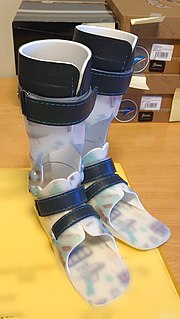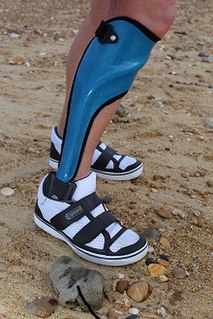
Biomedical engineering (BME) or medical engineering is the application of engineering principles and design concepts to medicine and biology for healthcare purposes. BME is also traditionally logical sciences to advance health care treatment, including diagnosis, monitoring, and therapy. Also included under the scope of a biomedical engineer is the management of current medical equipment in hospitals while adhering to relevant industry standards. This involves procurement, routine testing, preventive maintenance, and making equipment recommendations, a role also known as a Biomedical Equipment Technician (BMET) or as clinical engineering.

In medicine, a prosthesis, or a prosthetic implant, is an artificial device that replaces a missing body part, which may be lost through trauma, disease, or a condition present at birth. Prostheses are intended to restore the normal functions of the missing body part. Amputee rehabilitation is primarily coordinated by a physiatrist as part of an inter-disciplinary team consisting of physiatrists, prosthetists, nurses, physical therapists, and occupational therapists. Prostheses can be created by hand or with computer-aided design (CAD), a software interface that helps creators design and analyze the creation with computer-generated 2-D and 3-D graphics as well as analysis and optimization tools.
Prosthodontics, also known as dental prosthetics or prosthetic dentistry, is the area of dentistry that focuses on dental prostheses. It is one of 12 dental specialties recognized by the American Dental Association (ADA), Royal College of Surgeons of England, Royal College of Surgeons of Edinburgh, Royal College of Surgeons of Ireland, Royal College of Surgeons of Glasgow, Royal College of Dentists of Canada, and Royal Australasian College of Dental Surgeons. The ADA defines it as "the dental specialty pertaining to the diagnosis, treatment planning, rehabilitation and maintenance of the oral function, comfort, appearance and health of patients with clinical conditions associated with missing or deficient teeth or oral and maxillofacial tissues using biocompatible substitutes."
A pedorthist is a professional who has specialized training to modify footwear and employ supportive devices to address conditions which affect the feet and lower limbs. They are trained in the assessment of lower limb anatomy and biomechanics, and the appropriate use of corrective footwear – including shoes, shoe modifications and other pedorthic devices.

Anaplastology is a branch of medicine dealing with the prosthetic rehabilitation of an absent, disfigured or malformed anatomically critical location of the face or body. The term anaplastology was coined by Walter G. Spohn and is used worldwide.

An orthotist is a healthcare professional who specializes in the provision of orthoses. An orthotist has an overall responsibly of orthotics treatment, who can supervise and mentor the practice of other personnel. They are clinicians trained to assess the needs of the user, prescribe treatment, determine the precise technical specifications of orthotic devices, take measurements and image of body segments, prepare model of the evaluation, fit devices and evaluate treatment outcome. In the United States, orthotists work by prescription from a licensed healthcare provider. Physical therapists are not legally authorized to prescribe orthoses in the U.S. In the U.K., orthotists will often accept open referrals for orthotic assessment without a specific prescription from doctors or other healthcare professionals.
Assistive technology service providers help individuals with disabilities acquire and use appropriate Assistive Technology (AT) to help them participate in activities of daily living, employment and education.
Therdchai Jivacate is a Thai orthopedic surgeon and inventor known for his humanitarian activities in providing free prosthetic limbs to impoverished amputees, and for his development of techniques allowing low-cost, high-quality prostheses to be made from local materials. The activities of the Prostheses Foundation, which he founded in 1992 under royal sponsorship from the Princess Mother Srinagarindra, have expanded beyond the borders of Thailand to Malaysia, Laos, and Burma. Jivacate has established Thailand's first and only educational institution of occupational therapy at Chiang Mai University. He has also created an educational programme for children suffering from chronic diseases at Maharaj Hospital in Nakhon Ratchasima. In 2008, he was given the Ramon Magsaysay Award for Public Service.

Swami Vivekanand National Institute of Rehabilitation Training and Research is an autonomous institute functioning under the Ministry of Social Justice and Empowerment of India. It is located in Olatpur, 30 km from Cuttack.
Matthew Mirones is a former Republican politician from New York City who represented parts of Brooklyn and Staten Island in the New York State Assembly.
Commission on Accreditation of Allied Health Education Programs,, is an accreditation agency for postsecondary education programs in 30 health science fields.

Eneslow is a chain of shoe stores in New York City founded by the Low family in 1909. They are America’s largest pedorthic retailer. In addition to its retail stores, Eneslow also manages the Eneslow Pedorthic Institute, a pedorthic education and training program.

Orthotics is a medical specialty that focuses on the design and application of orthoses. An orthosis is "an externally applied device used to influence the structural and functional characteristics of the neuromuscular and skeletal system".
Kevin Carroll is an Irish prosthetist, researcher, educator, and author. He is the Vice-President of Prosthetics for Hanger Clinic, a prosthetics and orthotics provider in the United States.

The mechanics of the running blades used by South African former Paralympic runner Oscar Pistorius depend on special carbon-fiber-reinforced polymer prosthetics. Pistorius has double below-the-knee amputations and competed in both non-disabled and T44 amputee athletics events. Pistorius's eligibility to run in international non-disabled events is sanctioned by the International Association of Athletics Federations (IAAF).
PFA Footcare Association is a self-regulatory body which upholds, monitors and supports the competent and ethical practice of credentialed members. Supporting the Canadian Pedorthic profession and improving the foot health of Canadians.
Robert S. Gailey Jr., PT, PhD, FAPTA, is an American physical therapist; professor at the University of Miami Miller School of Medicine Department of Physical Therapy; and the Director of the Neil Spielholz Functional Outcomes Research & Evaluation Center. His research efforts include amputee rehabilitation, prosthetic gait, and functional assessment. He developed the Amputee Mobility Predictor (AMP), an outcome measure designed to evaluate the ambulatory potential of lower-limb amputees with and without the use of a prosthesis. In 2002, he was appointed as a Special Advisor to the United States Department of Defense for amputee rehabilitation. In the aftermath of the 2010 Haiti earthquake, he served as the rehabilitation coordinator for Project Medishare.
Ukraine Prosthetic Assistance Project is a project that aims at improving prosthetics and rehabilitation services in Ukraine through global exchange among the field specialists.
Jason D. Wening is an American managing clinician and former Paralympian.







